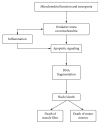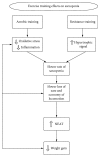Sarcopenia and Its Implications for Metabolic Health
- PMID: 30956817
- PMCID: PMC6431367
- DOI: 10.1155/2019/8031705
Sarcopenia and Its Implications for Metabolic Health
Abstract
Sarcopenia not only affects the ability to lead an active lifestyle but also contributes to increased obesity, reduced quality of life, osteoporosis, and metabolic health, in part due to reduced locomotion economy and ease. On the other hand, increased obesity, decreased quality of life, and reduced metabolic health also contribute to sarcopenia. The purpose of this mini-review is to discuss the implications sarcopenia has for the development of obesity and comorbidities that occur with aging.
Figures
References
-
- Goodpaster B. H., Park S. W., Harris T. B., et al. The loss of skeletal muscle strength, mass, and quality in older adults: the health, aging and body composition study. Journals of Gerontology Series A: Biological Sciences and Medical Sciences. 2006;61(10):1059–1064. doi: 10.1093/gerona/61.10.1059. - DOI - PubMed
Publication types
MeSH terms
Grants and funding
LinkOut - more resources
Full Text Sources
Medical




